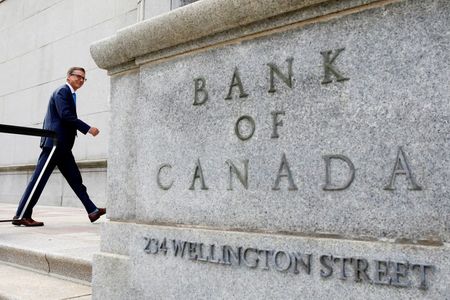By Julie Gordon and David Ljunggren
OTTAWA (Reuters) -The Bank of Canada on Wednesday took a mostly optimistic stance on the country’s economy, saying the threat of the COVID-19 pandemic had largely passed while warning inflation would remain hot in the near-term.
The central bank held its key interest rate at a record low 0.25% and cut its weekly net purchases of Canadian government bonds to a target of C$2 billion, expressing confidence growth would rebound strongly and this time be more durable.
“The reopening of the economy and the strong progress on vaccinations have given us reason to be more optimistic about the direction of the economy,” Governor Tiff Macklem told reporters after the rate decision.
“But we are not there yet, and we are mindful that the process is likely to be bumpy, and some scars will remain.”
Earlier, the bank said that while the third pandemic wave had slowed Canada’s economic growth in the first half of 2021, it should pick up in the third quarter.
The central bank said Canada’s economy is now expected to grow 6.0% in 2021, down from the April forecast of 6.5%, while it revised up its 2022 growth estimate to 4.6% from 3.7%.
“The downside risks associated with the pandemic have significantly diminished,” the bank said in its summer monetary policy report.
Inflation is expected to remain at or above 3% – the top of the bank’s 1%-3% control range – through the rest of 2021, easing back to the 2% target by 2022.
Macklem made clear the pressure on inflation is seen as transitory, reiterating that economic slack would be fully absorbed in the second half of 2022.
“There’s no indication that these strong inflation readings are forcing the bank to reevaluate their monetary policy,” said Josh Nye, senior economist at Royal Bank of Canada.
The central bank is expected to further trim its bond-buying program this year, setting the stage for a rate hike as soon as late 2022. But higher rates could come sooner, said Doug Porter, chief economist at BMO Economics.
“The ‘later’ risks would be driven by the virus, while the ‘sooner’ risks could arise if inflation remains stubbornly high and/or if growth is juiced more than expected by well-supported consumers,” he said in a note.
On employment, which lags pre-pandemic levels by roughly 500,000 jobs, a strong rebound is expected over the coming months and the central bank hinted that despite high long-term unemployment, scarring may not be as bad as initially thought.
“The workers most affected by the pandemic – namely, young people and workers with fewer skills – may face less risk of skills erosion,” the bank said.
The Canadian dollar was little changed on Wednesday, trading at 1.2510 to the greenback, or 79.93 U.S. cents.
(Additional reporting by Steve Scherer in Ottawa and Nia Williams in Calgary;Editing by Paul Simao and Steve Orlofsky)





